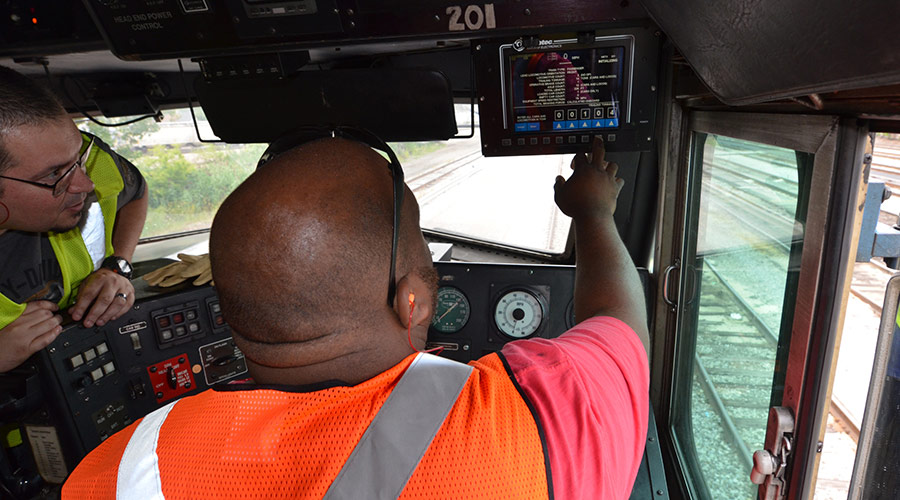Stay updated on news, articles and information for the rail industry
April 2015
Rail News: PTC
Positive train control: Suppliers continue to enhance their systems and components
— by Jeff Stagl, Managing Editor
Since positive train control (PTC) implementation was federally mandated in 2008, CSX Corp. has spent about $1.3 billion and handled thousands of tasks associated with adopting the technology. But similar to what most Class Is are facing, it'll take much more money and work for CSX to finish the PTC job.
The railroad is about 40 percent complete with implementation, which will cost a total of $1.9 billion, says CSX Vice President of Service Design Frank Lonegro, who is responsible for the Class I's PTC project.
About 70 percent of the 3,900 locomotives requiring devices have been worked on at least once — due to software development delays, CSX is prepping units first, and then installing hardware and software later. In addition, half of the old signal systems have been replaced with new ones on 7,500 miles of track; 40 percent of signal locations and dark territory switches requiring wayside interfaces have been addressed; and communications work only has progressed to a point due to Federal Communications Commission regulations on radio towers.
Implementation remains an ongoing challenge. For one thing, the sheer scale of the project is daunting, with thousands of wayside interface units (WIUs) and onboard devices to install, says Lonegro. Plus, the necessary onboard and back-office systems still haven't been fully developed, and there needs to be some regulatory clarity on a few points regarding the final PTC rule issued in August 2014, he says.
There is so much more to work through and accomplish that Lonegro believes CSX likely will need several more years to complete implementation. To that end, a bill was introduced in the Senate March 4 that would give CSX — and the dozens of other Class Is, commuter railroads and short lines impacted by the mandate — more time to adopt PTC.
The Railroad Safety and Positive Train Control Extension Act (S. 650) proposes to extend the deadline by five years to Dec. 31, 2020, as well as provide individual railroads another year or two beyond 2020 on a case-by-case basis. The Senate Committee on Commerce, Science and Transportation passed S. 650 on March 25.
"As an industry, we have been transparent and steadfast with regulators, politicians and others that the 2015 deadline will not be met. This new legislation parallels where the industry is and lands about where we believe our completion date will be," says Lonegro. "The industry believes it is an appropriate extension and hopes a similar measure will be introduced in the House."
To help CSX and other railroads implement the technology by whatever date possible, suppliers are providing complete turnkey systems and/or key components designed to meet the Federal Railroad Administration's (FRA) PTC functionality requirements. They also are trying to work with railroads to refine their product lines and services to best suit implementation needs.
Wabtec Corp. offers the Interoperable Electronic Train Management System (I-ETMS®) that's being installed by all the Class Is, more than 20 commuter railroads and a number of short lines.
Positive train control system
I-ETMS is designed to prevent track authority and speed-limit violations, unauthorized entry into work zones and train movements through a switch left in the wrong position. The system monitors and ensures a crew's compliance with all operating instructions, and provides a range of operating information to a train crew.
As a train moves down a track, the I-ETMS computer continuously calculates warning and braking curves based on all relevant train and track information, including speed, location, movement authority, speed restrictions, work zones and consist restrictions. The system also queries wayside devices for broken rails, proper switch alignments and signal aspects.
Over the past few years, Wabtec has obtained contracts to provide I-ETMS and other PTC equipment to Alaska Railroad Corp., Sound Transit, the North County Transit District, Denver Transit Partners (for three Regional Transportation District commuter-rail lines) and Metrolink, among others.
The supplier is focusing on helping railroads develop their plans for certification testing, says Jeff Stearns, Wabtec's VP of sales-locomotive electronics, declining to elaborate. The company plans to add features to I-ETMS that are tailored to a railroad's operations after certification testing — which is required prior to implementation — is completed.
To help perform more implementation work in the field for customers, Wabtec acquired Railroad Controls L.P. in early February. A RCL Services Group LLC subsidiary, Railroad Controls provides railway signal construction services to freight and passenger railroads in North America, including the installation of PTC-related equipment, and has extensive Class I experience.
At GE Transportation, the PTC product line includes a number of onboard and wayside components for I-ETMS, as well as a turnkey system.
In terms of onboard components, the company offers the GoLINC ancillary card cage, a mobile data center designed to provide "robust" processing, wireless communication, networking, video and data storage capabilities, according to GE. GoLINC interfaces with both locomotive and third-party systems to make data available, and features onboard wireless capability to ease data transfers.
GE also provides a Wireless Communications Module to add dual 4D LTE cellular data services with dual WiFi modems for multiple communications paths to support system availability; a Locomotive Interface Gateway data server designed to publish operational information from the locomotive control system to the PTC network, providing access to train speed, brake system status and other parameters; and an eMU device that allows the PTC network to be extended from the controlling locomotive to access spare equipment on trailing units to enhance system availability.
For the wayside, GE continues to offer products designed to interface signal systems to an overlay PTC system. A WIU function can be added to most existing electronic signaling installations with the company's PTC Processor WIU upgrade kits, according to GE.
PTC system connection
The company developed direct replacement circuit cards for wayside appliances to prepare existing wayside signal locations with electronic signaling for PTC system connectivity. The cards are logically identical to the installed units, except they include a PTC processor.
"Where there are electronic signals, capacity can be added without disarranging the signal location," says Joseph Noffsinger, a market development leader for GE Transportation.
For conventional relay signaling locations, GE offers an ElectroBlox WIU family of "building blocks" designed to monitor signal lamps or contacts and generate the PTC wayside status message for transmission to the locomotive. The blocks include a core WIU and more than 20 configurations of plug-in input/output modules to meet various interface requirements to legacy signaling.
GE also has attempted to address configuration management to help railroads meet the requirement in the FRA's PTC rules. The company enhanced its RAILDocs handheld device to support configuration management and recordkeeping for PTC wayside and onboard components, says Noffsinger.
In addition to supporting devices, GE long has offered a turnkey PTC system: the Incremental Train Control System (ITCS). Since 2009, Amtrak has been operating at 110 mph on a Michigan route featuring ITCS, and an effort is underway to double the mileage featuring the system, says Noffsinger. ITCS wirelessly communicates train movement authority as though a territory is operating under centralized traffic control and is designed to effectively double line capacity versus traditional control systems.
An enhanced version of ITCS is being released to a commuter-rail agency that will be interoperable with Class I PTC systems, says Noffsinger.
Alstom also is working with Amtrak and other rail customers on PTC implementation. The company currently is deploying its Advanced Civil Speed Enforcement System (ACSES) for Amtrak on eight lines and 1,600 track miles, and for New Jersey Transit on 11 lines and 545 track miles.
ACSES is designed to work in unison with traditional signaling solutions and customer operations to provide FRA-required PTC protection. The system has evolved from a first deployment on Amtrak's Northeast Corridor to a modern, IP-based solution, Alstom officials said in an email.
ACSES now includes Alstom's Microcabmatic OBC to control a train; MicroWIU to interface with wayside signaling components; Communications Management System to manage the radio and network resources; Safety TSR Server to handle the distribution of temporary speed restrictions to trains; and Data and Maintenance Services to collect and manage data and diagnostics.
Plus, a Transponder Transmission System — which features transponders located on the track and a transponder reader on the train — enables acquisition of fixed data by the OBC.
PTC functionality
In addition to the original positive train stop, speed restriction and temporary speed restriction protection offered by ACSES, the system now provides new functionality, such as positive train stop protection during turnback moves, grade crossing malfunction and roadway worker protection using temporary speed restrictions, and the protection of intermediate home signals for operation in Automatic Block Signaling territory, Alstom officials said.
Siemens Rail Automation also is making strides with its PTC system, which features an onboard unit, WIU and back officer server system. The Trainguard PTC Back Office Server includes flexible interface architecture for various connections and a built-in feature library that eases setup, Siemens officials said in an email.
For the WIU, Siemens has introduced the PTC Console that can monitor two switches and PTC-enables a Geographic Signaling System signal controller. The console is "right-sized" for smaller applications, Siemens officials said.
The company also provides the Trainguard PTC onboard unit featuring a built-in diagnostic display designed to ease installation and maintenance, and integrated spare slots and interfaces that can be used for future extensions, such as energy management.
The locomotive messaging server connects the onboard unit to the locomotive communication network and eventually to the back office server.
In case of a PTC system malfunction, Siemens provides a cutout switch to enable manual operation. In addition, a PTC Wheel Tachometer constantly checks the overall speed of the locomotive and compares it with the GPS location.
Siemens also offers a range of WIU products that include support for signal aspect, switch position and hazard device-based design.
Configuration information is stored on an Electronic Control Device to ensure the lowest possible mean-time-to-restore, and troubleshooting indicators and messages ensure a customer can quickly determine system health and a possible cause of performance problems, Siemens officials said.
Optimal performance also is key to Meteorcomm LLC, which is owned by BNSF Railway Co., Norfolk Southern Railway, CSX and Union Pacific Railroad.
Meteorcomm offers the ITCnet® PTC communications system that features a 220 MHz wireless and interoperable PTC network with base, locomotive and wayside radios. The 220 MHz radio that Class Is are adopting uses ITCnet to help communicate status between locomotives, wayside devices and back office systems to advance interoperability.
ITCnet is being adopted by all major railroads and has become a "system of choice" because of interoperability and reliability, says Keith Kosanovich, a senior product manager for Meteorcomm. Commuter railroads also are using the system because they operate over tracks owned by freight railroads, he says.
Meteorcomm's customers have performed extensive lab testing on their PTC systems, and now are transitioning to field quality testing as well as trying to move into revenue service demonstrations (RSDs) that require initial FRA approval, says Kosanovich.
"The RSDs will show the systems are working as mandated," he says.
As Meteorcomm obtains more customer feedback on ITCnet from field usage, the company might develop new versions of the system pertaining to messaging systems and radios, says Kosanovich.
With railroads figuring to work on PTC implementation for several more years, the need for additional product development and enhancements likely will keep mounting. So, suppliers aim to continue lending their expertise and providing optimal options to their railroad customers.
"Our focus now is on helping customers deploy and [demonstrate] their PTC systems," says Kosanovich.


 2025 MOW Spending Report: Passenger-rail programs
2025 MOW Spending Report: Passenger-rail programs
 Gardner steps down as Amtrak CEO
Gardner steps down as Amtrak CEO
 Guest comment: Oliver Wyman’s David Hunt
Guest comment: Oliver Wyman’s David Hunt
 Women of Influence in Rail eBook
Women of Influence in Rail eBook
 railPrime
railPrime







